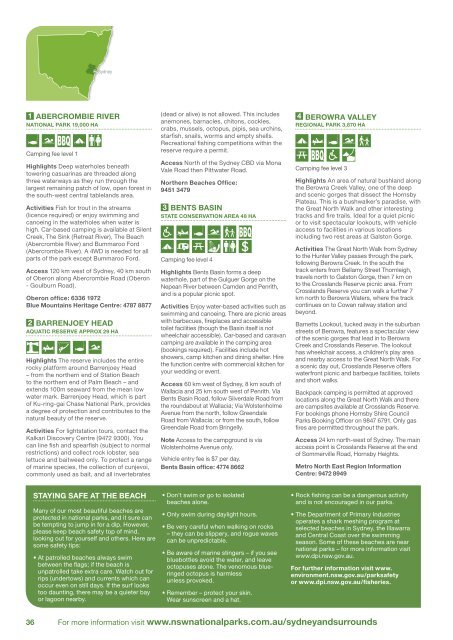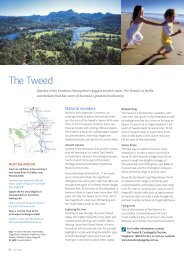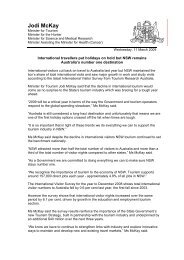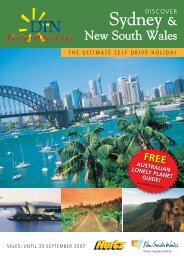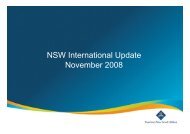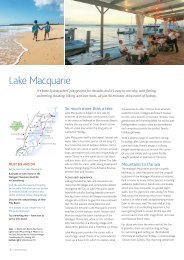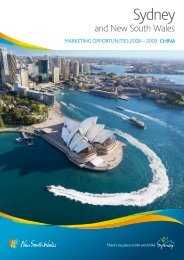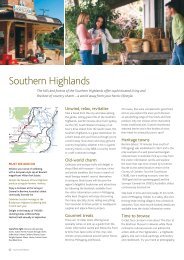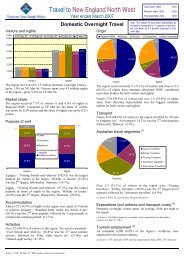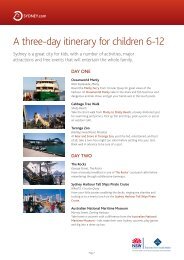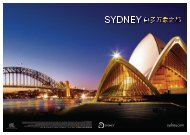Visitor Guide NSW National Parks 2011 - Hke Sydney
Visitor Guide NSW National Parks 2011 - Hke Sydney
Visitor Guide NSW National Parks 2011 - Hke Sydney
You also want an ePaper? Increase the reach of your titles
YUMPU automatically turns print PDFs into web optimized ePapers that Google loves.
1 ABERCROMBIE RIVER<br />
NATIONAL PARK 19,000 HA<br />
Camping fee level 1<br />
Highlights Deep waterholes beneath<br />
towering casuarinas are threaded along<br />
three waterways as they run through the<br />
largest remaining patch of low, open forest in<br />
the south-west central tablelands area.<br />
Activities Fish for trout in the streams<br />
(licence required) or enjoy swimming and<br />
canoeing in the waterholes when water is<br />
high. Car-based camping is available at Silent<br />
Creek, The Sink (Retreat River), The Beach<br />
(Abercrombie River) and Bummaroo Ford<br />
(Abercrombie River). A 4WD is needed for all<br />
parts of the park except Bummaroo Ford.<br />
Access 120 km west of <strong>Sydney</strong>, 40 km south<br />
of Oberon along Abercrombie Road (Oberon<br />
- Goulburn Road).<br />
Oberon office: 6336 1972<br />
Blue Mountains Heritage Centre: 4787 8877<br />
2 BARRENJOEY HEAD<br />
AQUATIC RESERVE APPROX 29 HA<br />
Highlights The reserve includes the entire<br />
rocky platform around Barrenjoey Head<br />
– from the northern end of Station Beach<br />
to the northern end of Palm Beach – and<br />
extends 100m seaward from the mean low<br />
water mark. Barrenjoey Head, which is part<br />
of Ku-ring-gai Chase <strong>National</strong> Park, provides<br />
a degree of protection and contributes to the<br />
natural beauty of the reserve.<br />
Activities For lightstation tours, contact the<br />
Kalkari Discovery Centre (9472 9300). You<br />
can line fish and spearfish (subject to normal<br />
restrictions) and collect rock lobster, sea<br />
lettuce and baitweed only. To protect a range<br />
of marine species, the collection of cunjevoi,<br />
commonly used as bait, and all invertebrates<br />
(dead or alive) is not allowed. This includes<br />
anemones, barnacles, chitons, cockles,<br />
crabs, mussels, octopus, pipis, sea urchins,<br />
starfish, snails, worms and empty shells.<br />
Recreational fishing competitions within the<br />
reserve require a permit.<br />
Access North of the <strong>Sydney</strong> CBD via Mona<br />
Vale Road then Pittwater Road.<br />
Northern Beaches Office:<br />
9451 3479<br />
3 BENTS BASIN<br />
STATE CONSERVATION AREA 48 HA<br />
Camping fee level 4<br />
Highlights Bents Basin forms a deep<br />
waterhole, part of the Gulguer Gorge on the<br />
Nepean River between Camden and Penrith,<br />
and is a popular picnic spot.<br />
Activities Enjoy water-based activities such as<br />
swimming and canoeing. There are picnic areas<br />
with barbecues, fireplaces and accessible<br />
toilet facilities (though the Basin itself is not<br />
wheelchair accessible). Car-based and caravan<br />
camping are available in the camping area<br />
(bookings required). Facilities include hot<br />
showers, camp kitchen and dining shelter. Hire<br />
the function centre with commercial kitchen for<br />
your wedding or event.<br />
Access 60 km west of <strong>Sydney</strong>, 8 km south of<br />
Wallacia and 25 km south west of Penrith. Via<br />
Bents Basin Road, follow Silverdale Road from<br />
the roundabout at Wallacia; Via Wolstenholme<br />
Avenue from the north, follow Greendale<br />
Road from Wallacia; or from the south, follow<br />
Greendale Road from Bringelly.<br />
Note Access to the campground is via<br />
Wolstenholme Avenue only.<br />
Vehicle entry fee is $7 per day.<br />
Bents Basin office: 4774 8662<br />
4 BEROWRA VALLEY<br />
REGIONAL PARK 3,870 HA<br />
Camping fee level 3<br />
Highlights An area of natural bushland along<br />
the Berowra Creek Valley, one of the deep<br />
and scenic gorges that dissect the Hornsby<br />
Plateau. This is a bushwalker’s paradise, with<br />
the Great North Walk and other interesting<br />
tracks and fire trails. Ideal for a quiet picnic<br />
or to visit spectacular lookouts, with vehicle<br />
access to facilities in various locations<br />
including two rest areas at Galston Gorge.<br />
Activities The Great North Walk from <strong>Sydney</strong><br />
to the Hunter Valley passes through the park,<br />
following Berowra Creek. In the south the<br />
track enters from Bellamy Street Thornleigh,<br />
travels north to Galston Gorge, then 7 km on<br />
to the Crosslands Reserve picnic area. From<br />
Crosslands Reserve you can walk a further 7<br />
km north to Berowra Waters, where the track<br />
continues on to Cowan railway station and<br />
beyond.<br />
Barnetts Lookout, tucked away in the suburban<br />
streets of Berowra, features a spectacular view<br />
of the scenic gorges that lead in to Berowra<br />
Creek and Crosslands Reserve. The lookout<br />
has wheelchair access, a children’s play area<br />
and nearby access to the Great North Walk. For<br />
a scenic day out, Crosslands Reserve offers<br />
waterfront picnic and barbeque facilities, toilets<br />
and short walks.<br />
Backpack camping is permitted at approved<br />
locations along the Great North Walk and there<br />
are campsites available at Crosslands Reserve.<br />
For bookings phone Hornsby Shire Council<br />
<strong>Parks</strong> Booking Officer on 9847 6791. Only gas<br />
fires are permitted throughout the park.<br />
Access 24 km north-west of <strong>Sydney</strong>. The main<br />
access point is Crosslands Reserve at the end<br />
of Sommerville Road, Hornsby Heights.<br />
Metro North East Region Information<br />
Centre: 9472 8949<br />
STAYING SAFE AT THE BEACH<br />
Many of our most beautiful beaches are<br />
protected in national parks, and it sure can<br />
be tempting to jump in for a dip. However,<br />
please keep beach safety top of mind,<br />
looking out for yourself and others. Here are<br />
some safety tips:<br />
• At patrolled beaches always swim<br />
between the flags; if the beach is<br />
unpatrolled take extra care. Watch out for<br />
rips (undertows) and currents which can<br />
occur even on still days. If the surf looks<br />
too daunting, there may be a quieter bay<br />
or lagoon nearby.<br />
• Don’t swim or go to isolated<br />
beaches alone.<br />
• Only swim during daylight hours.<br />
• Be very careful when walking on rocks<br />
– they can be slippery, and rogue waves<br />
can be unpredictable.<br />
• Be aware of marine stingers – if you see<br />
bluebottles avoid the water, and leave<br />
octopuses alone. The venomous blueringed<br />
octopus is harmless<br />
unless provoked.<br />
• Remember – protect your skin.<br />
Wear sunscreen and a hat.<br />
• Rock fishing can be a dangerous activity<br />
and is not encouraged in our parks.<br />
• The Department of Primary Industries<br />
operates a shark meshing program at<br />
selected beaches in <strong>Sydney</strong>, the Illawarra<br />
and Central Coast over the swimming<br />
season. Some of these beaches are near<br />
national parks – for more information visit<br />
www.dpi.nsw.gov.au.<br />
For further information visit www.<br />
environment.nsw.gov.au/parksafety<br />
or www.dpi.nsw.gov.au/fisheries.<br />
36 For more information visit www.nswnationalparks.com.au/sydneyandsurrounds


